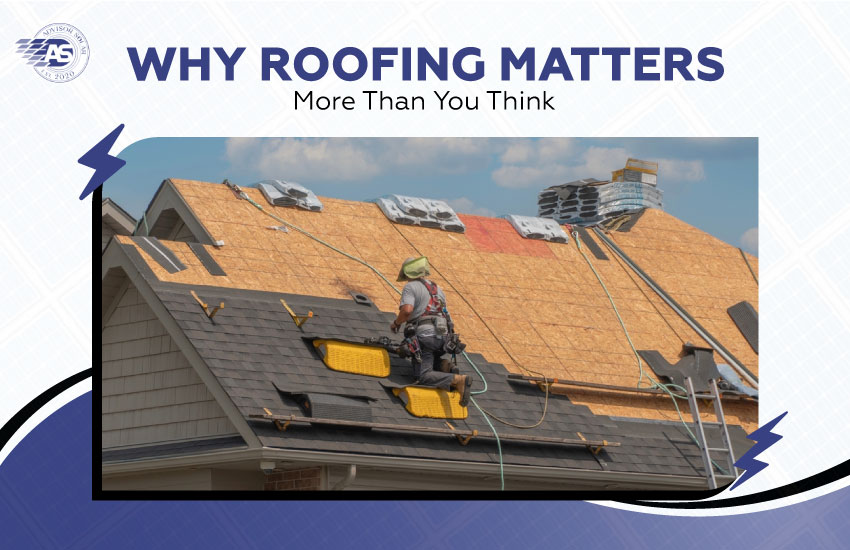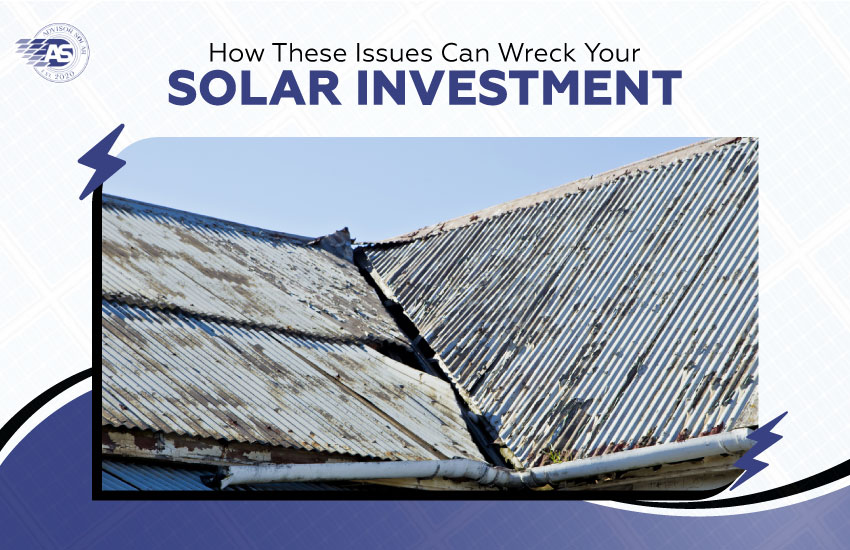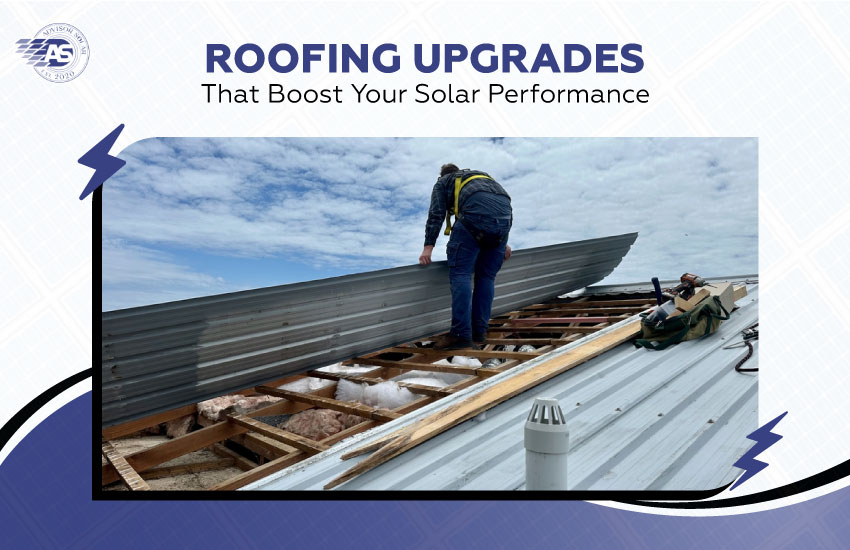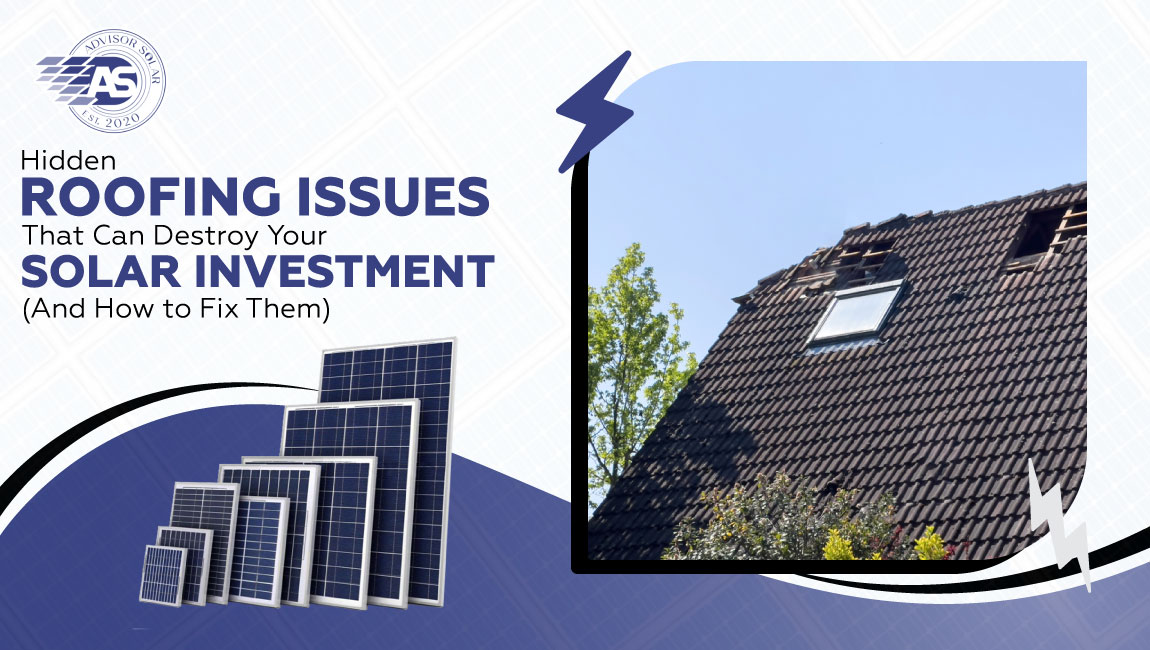Solar Panels Can Add Value to Your Home, but a Bad Roof Can Drain It. But did you know that adding solar panels can significantly increase that value? The reality is that many homeowners underestimate how essential their roof is to the success of their solar project. The U.S. Department of Energy highlights that about 25-30% of solar installations fail to take full advantage of a roof’s capacity due to improper design, poor installation, or inadequate roof preparation. This suggests that proper preparation is a critical aspect of the installation process. If not addressed, these issues can cause a loss of efficiency or total system failure. This is not simply a matter of putting solar panels on your roof; it also concerns whether your roof can support the added weight, the installation itself, and the decades of energy generation.
A roof that is not ready for solar installation can result in leaks, structural damage, and reduced panel efficiency, all of which waste your investment. This article will delve into some common secret issues with your roof that could doom your solar investment, from water damage and leaks to improper flashing and structural problems. We’ll also give you actionable advice about what to do about these issues before you install solar panels so your system can perform well for years to come.
By the time you finish reading this article, you’ll know the pivotal role your roof plays in solar energy performance and how to protect your investment to deliver the most return on your energy efficiency investments. Read on to discover how to safeguard your home, roof, and solar system from unseen threats.

Why Roofing Matters More Than You Think
For solar energy, most homeowners are concerned only with the solar panels themselves, believing that they are the most important part of their solar system. However, the reality is that your roof’s condition is equally, if not more, critical to the efficacy of your solar energy system.
Roof Condition Affects Solar Panel Performance
According to a 2021 report by the Solar Energy Industries Association (SEIA), it’s important to consider roof age, condition, and orientation when planning for solar panel installations. Even the most efficient solar panels underperform without a substantial, well-maintained roof overhead, leading to potential energy loss and substantial repair bills.
The Roof is the Foundation for Your Solar Panels
Your roof is the basis of your solar panels, and it has to be stable and solid enough to support their weight and withstand outdoor pressures. Most roofs today are rated to support the load of a traditional roof. Still, they may not be engineered to support the additional load of solar panels, particularly if they’re not in optimal condition.
The Weight of Solar Panels on Your Roof
Each standard solar panel weighs about 40 pounds, not counting mounting equipment, which can add a lot of weight to your roof. This excess weight can lead to sagging or, at worst, collapse in an aged or structurally compromised roof. According to the U.S. Department of Energy (DOE), roughly 30% of solar panel failures result from problems with the roof itself, including leaks and structural weaknesses.
How Roof Damage Can Impact Your Solar System
A damaged roof can potentially irreparably damage your solar system. Roof leaks, for example, can cause water to infiltrate and damage the roofing material and the solar panels underneath. Water penetrating the panel’s electrical components could cause system failure, voiding warranties and necessitating expensive replacements.
Case Study: The Cost of Roof Issues on Solar Panels
One customer had a leaking roof a year after their solar panels were installed, and the customer was responsible for covering the cost. The leak was due to incorrect installation and was a perfect example of how important it is to have your roof properly assessed by a professional before solar installation. (JustAnswer)
Protecting Your Solar Investment
If you are considering getting solar or already have it, understanding the essential influence your roof has on the performance and durability of your solar system is critical. If your roof is in poor condition, correcting these things before installing solar panels can avoid future complications and guarantee you the most return on your investment.
Note: Want to make sure your solar investment lasts for years? Read more in our recent blog, “The Importance of Roofing in 2025 for Solar Installations,” where we discuss in more detail how the condition of your roofing impacts your system’s performance and longevity.

The Hidden Roofing Issues Lurking Beneath Your Solar Panels
Before you ever install those solar panels, make sure to check out your roof to make sure it’s sound. Often, the most harmful problems lurk below the water line and may remain undetected until too late.
These kinds of hidden roofing issues stand to threaten your solar investment:
- Water Damage & Leaks
- Structural Weakness
- Rotting Wood & Mold
- Improper Flashing or Underlayment
1. Water Damage & Leaks
Water damage is one of the most common roofing problems that can also impact solar panels. If your roof leaks or is susceptible to water damage, the issues can be compounded once you add the weight of solar panels. It is important to note that leaks from the installation points, where the panels are bolted into your roof, can cause significant water infiltration that can affect both your roof and your solar panels.
- Cause: Inadequate sealing or damaged shingles.
- Risk: Water damage can ruin insulation, rot your roof structure, and cause short circuits in your solar system.
- Solution: Ensure the roof is completely waterproofed, including proper sealing around installation points.
2. Structural Weakness
Your roof is designed to support a certain degree of weight and pressure. However, solar panels, with their mounting brackets and other installation components, can significantly increase this weight. If your roof cannot support this additional weight, it could fail structurally, causing a more extensive leak.
- Cause: Weakening of the roof structure due to aging materials or poor installation.
- Risk: Structural failure, sagging roof, or panel dislodging.
- Solution: Consult with a structural engineer to assess the strength of your roof before installation and reinforce it if necessary.
3. Rotting Wood & Mold
Wood and other organic roofs are especially vulnerable to rot and mold growth. Such problems usually remain undetected until the roof is removed or fixed. Mold or rot underneath the surface of your roof can damage both the roof itself and any solar panels situated on top of it.
- Cause: Prolonged exposure to moisture and poor ventilation.
- Risk: Deterioration of the roof structure and corrosion of solar panel mounts.
- Solution: Inspect for mold and rotting wood during roofing inspections and replace damaged sections immediately.
4. Improper Flashing or Underlayment
Flashing and underlayment in the roofing system help prevent water infiltration. If the flashing is improperly installed or the underlayment is damaged, water may leak into the roof under the solar panels, leading to leaks, mold, and other long-term damage.
- Cause: Faulty installation or degradation over time.
- Risk: Water leaks leading to structural damage and solar panel malfunction.
- Solution: Replace damaged flashing and install proper underlayment before installing solar panels.

How These Issues Can Wreck Your Solar Investment
The last thing you want is to drop thousands on solar panels only to have them turn into an expensive liability due to roofing problems.
Here’s how these secret roofing issues can ruin your solar investment:
- Reduced Efficiency: Roof leaks and structural damage can cause your solar panels to lose efficiency. Stray water can seep into the electrical components, interfering with the power your system can produce.
- Increased Repair Costs: If your roof leaks or any structure starts to sag, you may have to remove and reinstall solar panels, adding charges. Your panels could need moving multiple times if your roof is not properly maintained, costing you financially.
- Shortened Lifespan: A failing roof shortens the life of the solar system. Panels can be exposed to moisture, which can lead to corrosion or electrical failure and can ultimately provide a shorter operating life.
- Damage to Roof and Solar Panels: Roof leaks and wood rot can cause direct physical damage to the solar panels, leading to expensive repairs or replacements of the roof and solar system.

How to Spot Roofing Problems Before It’s Too Late
The only way to stop hidden roofing issues from damaging your solar panels is to catch the potential problems early. Routine roof maintenance and inspections can help you avoid expensive repairs later on.
Here’s how to identify roofing issues before they affect your solar investment:
- Inspect your roof for visible damage: Go up to your roof and inspect it for any visible damage, such as missing shingles, cracks, or wear and tear.
- Look for dark spots or streaks: These may suggest mold or water damage at the roof.
- Check for leaks: A rainstorm is a good time to check for leaks inside your home, especially around solar panels.
- Examine the flashing and underlayment: Make sure that the flashing around chimneys, vents, and valleys is secure and properly sealed.
- Evaluate the age of the roof: If your roof is old (usually over 20 years), consider replacing it before adding solar panels.
- Check the roof’s structural integrity: Check the roof for sagging or signs that it is holding more weight than it ought to.
- Consult a professional: If you are still unsure, it is always a good idea to hire a professional roofer or solar
- installer to inspect your home.
- Monitor energy production: If your solar panels aren’t generating as much energy as expected, this might indicate underlying roof issues that are impacting the system.

Roofing Upgrades That Boost Your Solar Performance
If it’s time to repair or replace your roof, there are some strategic upgrades you can make — both to enhance its overall condition and the performance of your solar system:
- Replace old roofing materials: Composite shingles are light and durable, and they are easier to install solar panels over.
- Reinforce your roof’s structure: If you’re putting in solar panels, make sure your roof can bear the extra weight. Regardless of your base type, strengthen structural components as needed.
- Improve ventilation: Adequate attic ventilation reduces the chance of moisture buildup, which can lead to mold and rot.
- Opt for reflective roofing materials. These types can boost energy efficiency by reflecting sunlight away from the roof, reducing summer cooling expenses.
- Install proper flashing and underlayment: Ensure your roof is fully sealed with quality flashing and underlayment to avoid water entering.

Why Advisor Solar is the One-Stop-Shop for Solar & Roofing
Installing solar panels is a great investment in your home and the environment, but it’s important to make sure your roof can handle the job. Unifaced roofing problems, such as leaks, weak spots, or medium flashing, can interfere with your solar system’s performance. Being aware of potential issues you could face before installing the system can help you protect your investment, gain maximum savings on your energy bill, and avoid spending a fortune on repairs.
These options depend heavily on the square footage and quality of your existing roof, which often coincides with the roof being a flat, sloped, metal, or tiled surface. At Advisor Solar, we specialize in both roofing and solar installation. That is why we provide a complete solution that integrates both of those services. This means your roof is equipped for many years of clean energy generation. Here’s what makes us your best choice:
- Expertise in both solar and roofing: Our team of experts handles it all— from roof inspections to solar panel installation and roof maintenance.
- Tailored solutions: We evaluate how your roof looks before installing and recommend any upgrades to your roof to make sure your solar system runs optimally.
- Seamless process: Rather than working with multiple contractors and being able to make a well-informed decision about your roofing and solar installation, we schedule everything from roofing repairs to solar panel installation.
- Financing options: We have a huge variety of financing options to help make solar energy affordable for every home and business.
Contact Advisor Solar today if you’re ready to begin your solar journey or if you require guidance on how to integrate solar with your roofing. We will help you get the most out of your solar investment by making your roof ready for the job.
FAQs
Slate, wood, or clay tile roofs are not suitable for solar panels. The coatings are difficult to work with and do not necessarily support the weight of solar panels without further reinforcement or modification.
Solar professionals ensure that the roof is properly prepared by using mounting brackets and sealing properly, ensuring that it is not damaged and will not leak during installation.
A solar panel installation rarely causes a roof to leak. However, they can also happen if panels were poorly installed or if the roof was in poor condition before the panels were installed, so a proper inspection is necessary.
Yes, a roof can be replaced without removing the panels. Still, the roofer and solar installer must collaborate, and extra care must be taken to avoid damaging the panels, wiring, and overall integrity of the system during the replacement.
A certified roofing contractor or solar installer can evaluate your roof’s structure and condition to see if it can safely and effectively hold the extra weight and installation specifications from solar panels.

